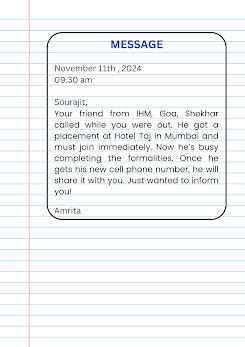MESSAGE WRITING
Message writing in English involves conveying information briefly and clearly, often in response to a phone call or a situation where someone is unavailable. The key is to be concise, accurate, and include all necessary details within a limited word count.
Here's a breakdown of the essential elements:
1. Structure and Format:
Heading: Start with the word "MESSAGE" in capital letters at the top center.
Date and Time: Write the date and time of writing the message on the left side of the page.
Salutation: While not always necessary, a brief salutation like "Dear [Name]" can be included, especially in formal messages.
Body: This is the core of the message. Include all important information like the name of the person who called/left the message, the reason for the message, and any specific instructions or requests.
Sender's Name/Signature: End with the sender's name or signature.
Box: Enclose the entire message within a box.
2. Key Considerations:
Brevity: Messages should be short and to the point, typically within a 50-word limit.
Clarity: Use simple, clear language to avoid any misinterpretations.
Accuracy: Double-check the information to ensure it is correct and complete.
Indirect Speech: Use indirect speech when reporting what someone else said (e.g., "He said he would call back later.").
Formal vs. Informal: Adapt the language and tone to the context (formal for professional messages, informal for personal ones).





No comments:
Post a Comment